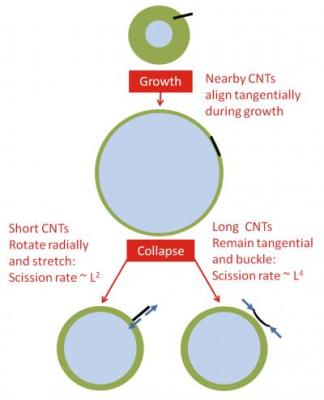Carbon nanotubes which were discovered two decades ago are hollow tubes of carbon with the same dimensions as a DNA strand. Nanotubes have enormous potential for application in diagnostics and disease treatment, sensors and paintable batteries and in new generation power cables.
 The mechanism by which carbon nanotubes break or bend under the influence of bubbles during sonication is the topic of a new paper led by researchers at Rice University. The team found that short nanotubes are drawn end-first into collapsing bubbles, stretching them, while longer ones are more prone to breakage.
The mechanism by which carbon nanotubes break or bend under the influence of bubbles during sonication is the topic of a new paper led by researchers at Rice University. The team found that short nanotubes are drawn end-first into collapsing bubbles, stretching them, while longer ones are more prone to breakage.
From an industrial application perspective, nanotubes usually have to be processed in liquids. This poses problems as nanotubes in liquids have a tendency to bunch up together. Over the years, researchers have employed ultrasonic vibrations to separate the nanotubes. A recent study at Rice University which is credited for discovering many of the material and optical properties of carbon nanotubes shows that the process of sonication could actually be detrimental to nanotubes.
The process of separating the nanotubes results in a reduction in length of the nanotubes. Scientists have formulated an equation dubbed the “power law” for determining the average length of isolated nanotubes when subjected to a specific level of sonication power for a given period of time. The nanotubes were found to get shorter with increase in exposure and time. However, there are two such power laws formulated with accompanying experiment results.
The team at Rice University began to study the sonication of nanotubes to resolve the discrepancy between the two laws by applying fluid dynamics concept to simulate the process for both short and long nanotubes. The researchers discovered that short nanotubes stretch because the bubbles produced by ultrasonic vibration draw out one end of the short nanotubes towards the bubble centre, ultimately causing them to break. They found that long nanotubes bend because the bubbles drew them inward from the center. This also ultimately leads to breaking. The team concluded that both the laws are correct as one explained the mechanism for short nanotubes and the other describes the mechanism for long nanotubes.
Source: http://news.rice.edu/